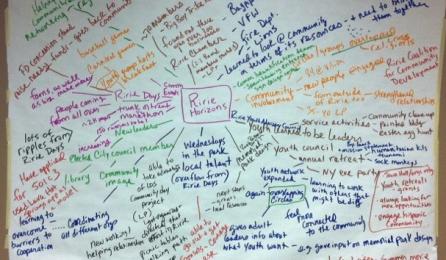Ripples, Spirals, Loops and Love: Mapping a Networked Change Effort
April 9, 2020 2 Comments
About a month ago, I worked with a regional education network focused on racial equity in education to do ripple effect mapping (REM) based on the past three years of its work to diversify the teacher workforce, including efforts to help paraprofessionals advance into formal teaching roles. REM is a technique to evaluate the results of an initiative or intervention by pulling together a diverse and representative group of stakeholders to make sense of the impacts they see as rippling through the system. The methodology is very participatory and has extra added benefits of helping to strengthen relationships and understanding between what otherwise might be siloed stakeholders. REM can also help to guide the refinement of a theory of change (rooted in actual experience!) and lift up areas for further investigation, including barriers to and accelerators for greater impact and systemic shifts.
Ripple effect mapping combines four different methods: peer interviews, group sense-making, mind mapping, and qualitative data analysis. In general it happens through the following steps:
- Conduct a stakeholder analysis to identify the right set of participants that has participated in the initiative, including beneficiaries, implementers, sponsors, key decision-makers, resource providers, those with relevant expertise and lived experience, and critical connectors/boundary spanners.
- Convene the identified group. Our convening was a bit larger than the recommended size of 15-20 people – we had about 35 people representing different roles, institutions, geographies, perspectives and backgrounds.
- During the convening, conduct interviews using Appreciative Inquiry questions. Appreciative Inquiry invites people to reflect on the positive aspects of a project. We had people share something positive that they had experienced or witnessed associated with the project, including outcomes, relationships, learning, new collaborations, etc.
- Do a group mapping session, during which people build on what they shared and heard in the interviews, brainstorm and record the effects (the “ripples”) of the initiative or intervention. We used a large bank of chart paper and large stickies with two facilitators (one to steward the conversation, the other to place and move stickies) and several scribes. The resulting “mind map” illustrates the effects of the intervention and explores connections, causality, and virtuous cycles. Before ending the mapping session, we invited people to “take a step back,” take in the map and ask what stood out to them, what seemed most important, and what they wanted to know more about.
- Clarify, connect, code, and analyze data. After the session, a smaller group organizes the mind map and collects and connects additional details by following up with participants.

This week a small team of us met for a second time (virtually, of course) to make sense of the data, including notes that were taken by a recorder and photographs of the mind map. It was helpful to do this in two meetings as there was a considerable amount of data, people are reeling from COVID, and it was important to have some time in-between the two sessions to do some more individual reflection, looking for patterns in the data.
In this second meeting, we started threading together our individual reads, and also reminded ourselves that we are dealing with complex systems and as such, linear causality is not necessarily what we should be looking for. What began to emerge as we talked (over the course of two hours) was a circular, or spiral, progression and lattice-work of nested impacts. We started to think in terms of “causal loops,” DNA helixes, and networked flows. An overarching question started to form –
What intersecting “virtuous loops” are we learning need to be supported to advance change and overcome “vicious loops” oriented towards keeping the system(s) as it/they are?
What we are working with as a core loop/spiral (for now) is the following:
- People who care and are committed come together across boundaries (districts, schools, roles, disciplines, perspective, culture)
- People practice deep listening to and learning from paraprofessionals, students, one another …
- People start making different choices and behaving differently (changing job descriptions, altering programs to accommodate spoken and respected needs, engaging in mutual support, moving from competition to collaboration between programs, sharing information more transparently)
- People start to taste “transformation” (a sense of their and others’ potential, the power of lived experience in the classroom, the essential nature of community, the benefits of working together)
- The resulting enthusiasm feeds back into care and consideration, and the cycle repeats, and ideally takes in more people … (we have seen some evidence in this as paras become seen as leaders and mentors to other paras)
This core loop operates at and across different levels:
- The individual “beneficiary” level (students and para-professionals)
- The individual support level (mentors, teacher prep educators, those who hire/fire/retain)
- The individual school level
- The district/teacher prep program level
- Larger system levels (community, state policy and support)
And the loop will play out in different ways in different contexts. And so we are asking about differences and similarities across systems (trans-contextual, in the words of Nora Bateson).
This is all very emergent and still exploratory, as it should be, and we will continue to make meaning and test take-aways. And I think that we would all agree that the foundation of all of this is care, or a word we like to use at IISC – love. One definition of love is “seeing and treating the other as a legitimate other.” If we don’t begin with this at the level of students who we see as deserving to have the benefit of having teachers who look like and can experientially relate to them, if we do not see and believe in the potential, humanity and “expertise” of para-professionals of color, well, we go no where.
And so we continue to mull over and be guided by the dynamic “ripples and collisions” (in the words of a network participant) of this work to what we hope will be a better place …
2 Comments
Thank you once again Curtis. Your articles insights and sensibilities expand the proverbial table. We all seek validation and acceptance within our respective communities and organizations. Diversity grows dignity, self respect and heighten awareness of the positive possibilities we hold. Curtis thank you for “keeping it real”.
Thanks, T! Appreciate the appreciations:).